![]()
![]()
![]()
Use LEFT and RIGHT arrow keys to navigate between flashcards;
Use UP and DOWN arrow keys to flip the card;
H to show hint;
A reads text to speech;
34 Cards in this Set
- Front
- Back
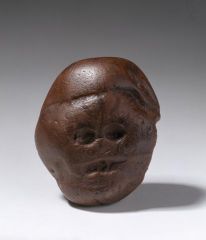
|
Makapansgat Pebble Resembling a Human Face,
c. 3,000,000 BCE, jasperite, from South Africa ; is this a work of art???? |
|
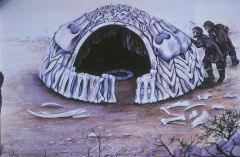
|
Reconstruction of a mammoth-bone structure, ca. 1 million to 10,000 BCE
Paleolithic Period (40,000-8100 BCE) basic architecture (bone=palolithic) |
|
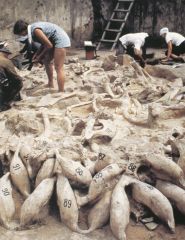
|
Remains of a mammoth-bone structure,
Ukraine, ca. 10,000 BCE |
|
|
main distinction and major debate of prehistoric period??
|
No recorded writing; what is art (what counts)
|
|
|
cro-magnon
|
early civilization (group of people) .. associated w/ examples of western art . They were intelligent; had common language; stuck together; EVOLUTIONARY group
|
|
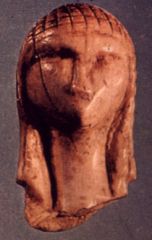
|
Woman from Brassempouy, from France,c. 30,000 BCE/Paleolithic, ivory ;
art by cromagnums all have common feature (women, animals, combination) |
|

|
Lion-Human, from Germany,
c. 30,000 BCE/Paleolithic, ivory (they thought humans & animals to live as one common group, sharing the world) Creativity. |
|
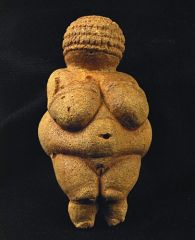
|
Woman from Willendorf, c. 22,000-21,000 BCE/Paleolithic, from Austria, limestone, ORIGINALLY painted by okra (red)
exaggerated female attributes (wide hips, dimpled knees & butt, solid thighs) IDEAL woman ; represented fertility; talisman?(good luck charm) |
|
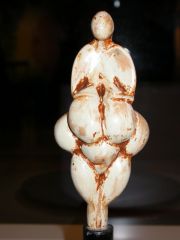
|
Woman from Les Pugue, France, c. 25,000 BCE,
Painted limestone : Types of sculptures : in the round (completely around) |
|
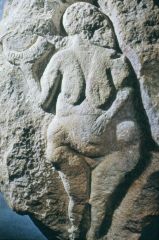
|
Woman Holding a Bison Horn, Laussel,
France, c. 25,000 BCE, painted limestone ; RELIEF sculpture (carving) |
|
|
What's so significant or special about prehistoric cave paintings?
|
the pantings were done in deep parts, not where ppl lived, of the cave that requires special lighting and makes them sacred. & they are animals.
|
|

|
Bison, detail from the ceiling at Altamira cave, Spain, c. 12,000-11,000 BCE ; high relief (bc of use of natural stone characteristics); 3d effect
|
|
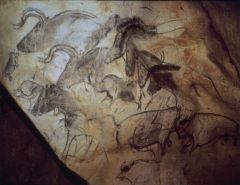
|
Horses, Rhinoceroses, and Aurochs, Chauvet Cave, France, c. 30,000-28,000 BCE/
Paleolithic, paint on limestone ; France contains the OLDEST cave paintings |
|
|
contour
|
outline, basic shape (drawing w/ outlines)
|
|
|
value
|
shading of gray in some areas of drawing/paintings that indicates color, volume & gives sense of 3d value.
|
|
|
overlapping
|
common strategy (overlapping strategy) to show different time periods)
|
|
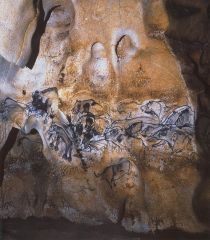
|
Lion Panel, Chauvet Cave, France ; realistic animals that seem to have senses of movement
|
|
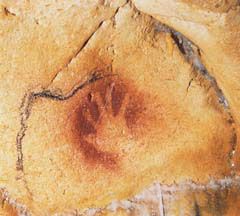
|
Handprit in Chauvet Cave on france ; first form of signature
|
|
|
Lascaux Cave
|
in france ; one of the better known; a narrative of stories being told ; closed decades ago bc of affeected paintings
|
|
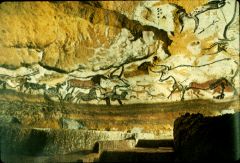
|
Hall of Bulls, detail from paintings at Lascaux Cave, France twisted perspective
c. 15,000 BCE |
|
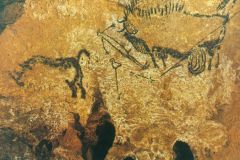
|
Bird-Headed Man with Bison, detail from paintings in Lascaux Caves, France; a myth ? why is the person a stick figure & the animale so intricate? is it the vision of a shaman?
|
|
|
shaman
|
mystical figure; sometimes medicinal hero
|
|

|
Limestone lamp , Lascaux Cave, France
|
|
|
Neolithic period characteristics?
|
Ice age ending (climate changes), settling down. 3 main things!!! 1. agriculture (food), men women & children have roles 2. animals have a job/task, they are put to work. 3. permanent homes
|
|
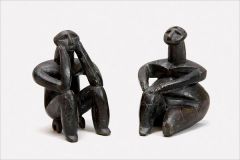
|
Woman and Man from Cernavoda, Romania, Neolithic, c. 3500 BCE, ceramic(hardened clay fired in ovens) ; found @ burial site.. Hudband & wife? ; abstracted
|
|
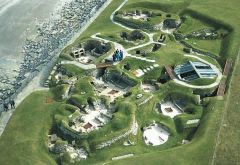
|
Compound at Skara Brae, Scotland, c. 3100-2000 BCE
|
|
|
masonry
|
the building of structures from individual units laid in and bound together by mortar
|
|
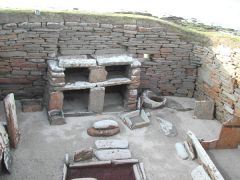
|
House Interior, Skara Brae
|
|
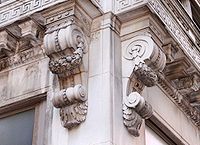
|
piece of masonry jutting out of a wall to carry any superincumbent weight ; corbeling
|
|
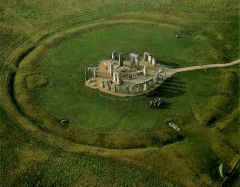
|
Stonehenge; salisbury plain, wiltshire England, 3,000-1500 bce ; one of the most complex (8 phases of construction that went halfway through bronze age, -over a millenium)
|
|
|
henge
|
circle of stones or posts, often surrounded by a ditch
|
|
|
most basic type of construction?
|
POST & LINTEL
|
|
|
moruse-and-tenon
|
construction; knot & groove
|
|
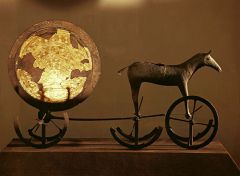
|
Horse and Sun Chariot, from Denmark, c. 1800-1600 BCE, bronze ; covered in thin sheet of gold; symbolic: religion ??? ; marks end of prehistoric period & beginning of bronze age
|

